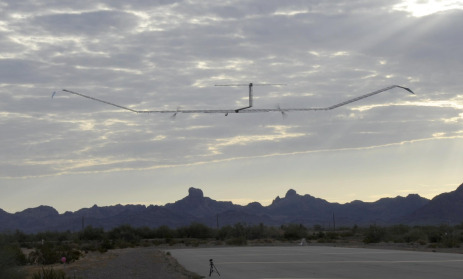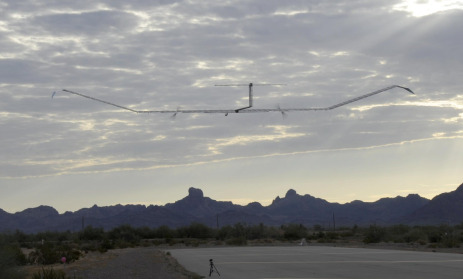 The “Zephyr,” a solar drone, has been airborne for two weeks.Photo: QinetiQThe climate bill is dead — moment of silence — but plenty of other stories came to life this week. From an oil spill strategy that backfired to solar-driven drones and wifi, here are 10 green stories to share over the weekend.
The “Zephyr,” a solar drone, has been airborne for two weeks.Photo: QinetiQThe climate bill is dead — moment of silence — but plenty of other stories came to life this week. From an oil spill strategy that backfired to solar-driven drones and wifi, here are 10 green stories to share over the weekend.
- Seemed like a good idea at the time: Last April, when it looked like the coast of Louisiana was about to be coated in brown ooze, Gov. Bobby Jindal ordered valves opened on the Mississippi River. The valves are there to divert freshwater into the marshes as a way to reduce salinity; Jindal figured the extra flush of river water would push away the oil. It may have helped, although no one’s sure how much. What they do know is that it also seems to have killed a lot of oysters. The AP’s Cain Burdea delivers the irony.
- Hold the vinegar: China’s dealing with its own oil spill at the moment, but it’s added another arrow to the shockingly slim cleanup quiver: bugs. Actually, bugs that eat oil. (Okay, technically, they’re bacteria.) The Beijing company that provided 23 tons of them to chow on the spill calls them “environmentally friendly microbial products.” We’ll stick with bugs. Chuin-Wei Yap, writing for the Wall Street Journal‘s RealTimeChina Report, has more.
- The revolution will be on wifi: As any college student will tell you, if you don’t have good wifi, well, why live? So two guys at the Rochester School of Technology wanted to reassure the world that you can create a wifi hotspot off the grid. They used a wind turbine and a solar panel. Get the lowdown at Hackaday.
- Droning on: If it stays aloft through Friday, a drone circling above the Army’s Yuma Proving Ground in Arizona will have been airborne for 14 days — twice as long as the previous record for continuous unmanned flight. Impressive. More impressive is that it’s droning on solar power. The plane, named Zephyr, is being billed as the “world’s first truly eternal plane.” That’s a lot of bags of peanuts. John Collins Rudolf has the story in the New York Times Green blog.
- Make that the Green Angels: Not easily impressed? How about a Navy jet flying on algae? A San Francisco company named Solazyme has handed over 1,500 gallons of algae biofuel to the Navy for testing. The Navy has a goal of operating 50 percent of its fleet on renewable fuel by 2020, and if anything can help it get there, shouldn’t it be sea gunk? There’s more at BrighterEnergy.
- Not much of a cleansing: The Jordan River has become so polluted that the Israeli government is considering closing the spot where, scripture has it, Jesus was baptized. Drought and irrigation have shrunken the river to a sewage-heavy stream at the site near Jericho, which actually is on the boundary between Israel and Jordan. As many as 100,000 tourists arrive every year and many of them wade into the water. Not such a good idea. Israel soon may post signs reading: “Polluted Waters, Entry Forbidden.” Here’s the story in the Jerusalem Post.
- Do the white thing: Here’s a tip from the very top: White roofs are cool. Energy Secretary Steven Chu made it the official policy of the Energy Department this week that any new roofs on its buildings will henceforth be white. By his estimate, this will save the government $735 million a year on its energy bills. See Brit Liggett’s story at Inhabitat. Pretty great, huh? But how about mandating the replacement of all those old fluorescent and incandescent light bulbs, wonders Ashley Braun at Grist?
- Little lumen: Solar cells are becoming so small that the next generation could be as little as lint — which opens all kinds of possibilities for embedding them in windows or fabric or the roofs of cars. Janet Raloff, at Science News, provides the electrifying details.
- Honda wants to be your hybrid: Just not quite yet. But starting next year all Civics made in Japan will be hybrids, and, by 2013, Honda plans to offer hybrid versions of five of its models. Look for a fully electric Honda car in the U.S. in 2012. Check out Leon Kaye’s story at Triple Pundit.
- Just don’t get any ideas about watering it: Acknowledging that there are few things as ugly as a highway sound baffle, the Ohio Department of Transportation is going natural. It plans to start testing a living wall built from specially-designed bags of dirt and seeds. In theory, at least, once the barrier is in place, a stretch of I-70, east of Columbus will feature one giant, sound-muffling, chia pet. Alyssa Danigelis plants a seed at Discovery News.
Secure · Tax deductible · Takes 45 Seconds
Secure · Tax deductible · Takes 45 Seconds



